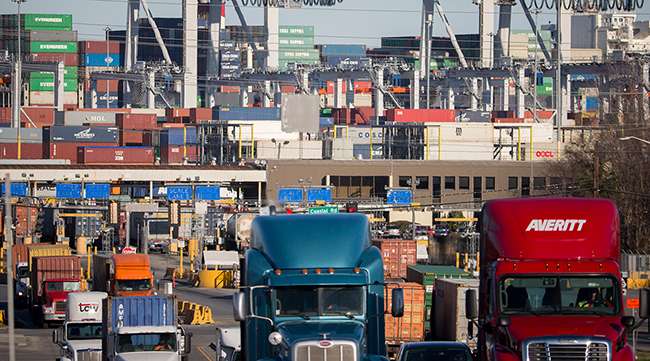Georgia Ports Shrug Off Trade Worries, Post Record Year

Georgia’s seaports shook off fears of global trade tensions and the early days of the partial government shutdown to post another record year of freight traffic in calendar year 2018, a sign the economy remains sound despite recent turmoil.
Georgia’s inland and coastal ports are vital cogs in the state’s economy, and in some ways canaries in the global economic coal mine. The volume of cargo that flows in and out of the Savannah and Brunswick harbors are bellwethers of U.S. demand for imports and of the appetite abroad for Georgia grown or manufactured products.
On Jan. 29, the Georgia Ports Authority said the Savannah harbor moved 4.35 million 20-foot equivalent containers, or TEUs, up 7.5% from a year earlier. Last year brought nine of the authority’s 10 busiest months on record, including December, when container volume grew by 8.7% compared with December 2017.
So far in the fiscal year’s first six months, July through December, container traffic is up 8.6%.
Trade tensions between the United States and China and instability elsewhere have been a headwind for the global economy. Georgia Ports Authority Executive Director Griff Lynch said the authority noticed a slight slowdown in exports from some smaller Georgia companies, but trade overall continues to grow.
“No. 1, the economy is strong and that’s good news,” Lynch said.
A recent study by the University of Georgia found that maritime trade accounts for $44 billion of the state’s gross domestic product, and the ports directly or indirectly touch more than 439,000 jobs.
The state’s freeway and rail network, not to mention the ports and Hartsfield-Jackson International Airport, make Georgia a vital link for commerce throughout the Southeast and beyond.
The month of December reached record traffic despite the beginnings of the partial federal government shutdown that led to members of customs and the U.S. Coast Guard working for weeks without pay. The ports, Lynch said, are grateful to federal employees who ensured the shutdown didn’t endanger or crimp the flow of cargo.
The ports authority has been on a building binge in recent years to maintain capacity amid substantial growth in freight traffic.
On Jan. 29, the authority said plans are in the works for a 400-acre expansion at the Brunswick port on land it already owns because of growth in shipments of autos and machinery.
The nearly $1 billion dredging to deepen the Savannah River hit a milestone in 2018 when the U.S. Army Corps of Engineers completed the outer harbor deepening. Inner harbor work is slated to begin this year, with the full deepening scheduled for completion in late 2021.
The deepening of the river to 47 feet is needed to accommodate ever-larger freighters that are plying through the expanded Panama Canal.
Though the river channel is soon to reach a depth of 47 feet, another potential choke point is emerging: Savannah’s Talmage Memorial Bridge. Lynch said the ports and the state Department of Transportation are studying whether a taller bridge — or perhaps tunnels — should be built to replace the span, which was completed in 1991.
The ports don’t have an issue with the bridge today, but it will become an issue as shippers order bigger freighters.
Lynch told state lawmakers earlier this month such a project could cost $1 billion.
“The port that wins is the port that can handle the big ships of the future,” he said. “It’s going to happen. It’s a matter of when.”
During 2018, the ports opened an inland rail terminal in northwest Georgia and announced plans to build another in northeast Georgia. The inland ports extend the gates of the Savannah terminal and free up capacity on roadways throughout the state.
A larger percentage of freight is being moved into and out of the Savannah port via rail, and that’s only expected to continue.
The Mason Mega Rail Terminal, a sprawling new rail yard designed to improve the Savannah terminal’s connection to the main CSX and Norfolk Southern rail networks, is about 25% complete, Georgia Ports Chairman Jimmy Allgood said.
The rail project is expected to open its first phase this year and be completed by the end of 2020. Eventually, it could take some 200,000 big rig trucks off the state’s freeways — even as container traffic in and out of the port grows, ports officials have said.
Distributed by Tribune Content Agency, LLC

